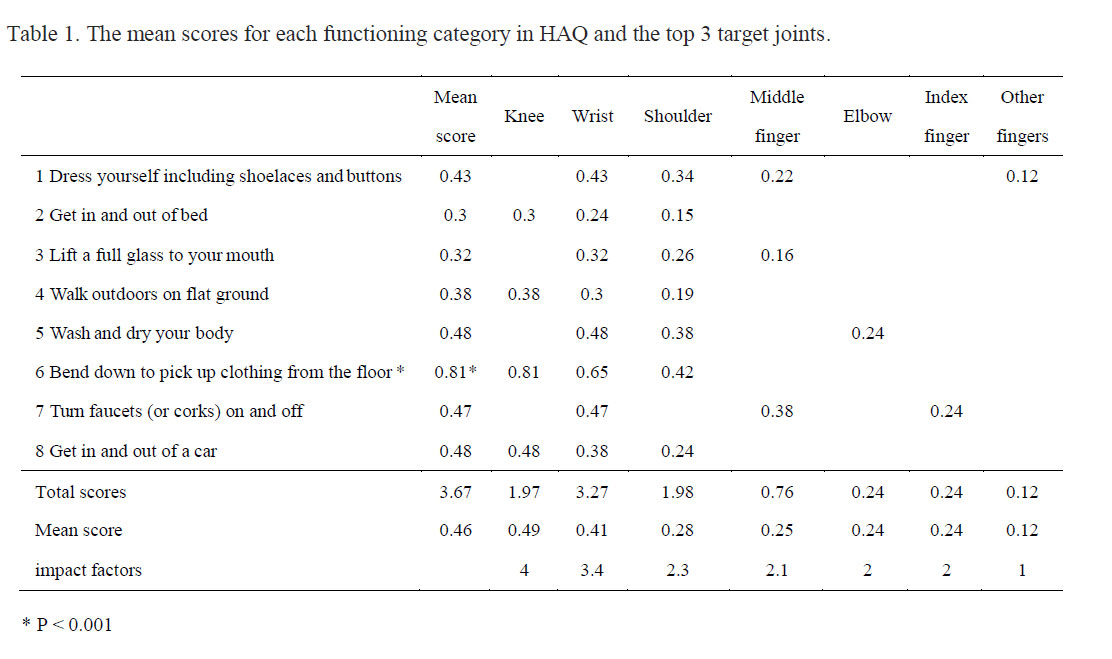Session Information
Date: Monday, November 11, 2019
Title: RA – Diagnosis, Manifestations, & Outcomes Poster II: Treatments, Outcomes, & Measures
Session Type: Poster Session (Monday)
Session Time: 9:00AM-11:00AM
Background/Purpose: Treat to target (T2T), achieving a DAS28 score lower than 3.2, is the strategy recommended by ACR and EULAR. Health assessment questionnaire (HAQ) is the most widely used in assessment of physical function in RA. However, the T2T may not be always associated with low HAQ score. The purpose of this study is to quantify phenomena of mismatch between T2T and HAQ in RA patients and identify influential factors from real-world data mining in SSDM.
Methods: SSDM are mobile APPs of disease management. The patients were trained by physician to conduct their DAS28 and HAQ self-assessments with SSDM. The data were synchronized with physicians’ and uploaded onto cloud for analysis.
Two phases studies were designed. Phase I: from June of 2015 to May of 2018, to identify impact factor for mismatch; phase II: from June 2018 to May 2019, validation.
Results: From June 2015 to May 2019, 54,149 RA patients from 587 hospitals in China used SSDM, of which 41,234 patients made 84,538 times of DAS28 & HAQ self-assessments. Phase I: Total 48,751 assessment from 25,151 patients included. Among them, 25,738 assessments from 13,110 patients reached T2T. The mean numbers of tender and swollen joints were 1.53 and 1.32, respectively. However, 8,762 assessments (34.04%) of 5,905 patients had abnormal physical function (HAQ > 0), which score for 8 functional tests was 3.67. The “Bend down to pick up cloth from the floor” was the commonest, with a mean score of 0.81, significantly higher than other functional test score, P< 0.001. The analysis of correlation between physical dysfunction and the affected joints showed the knees were the major contributor to the mismatch, following by wrists and shoulders. Table 1 showed the mean scores for each functioning category in HAQ and the top target joints. According to the cluster weights for the impacts of affected joints on physical function, the weighted coefficient of impacting factors (IF) on physical function was obtained: knee=4, followed by wrist=3.4, shoulder=2.3, middle finger=2.1, elbow=2, index finger=2, other finger=1. Phase II: total 35,787 assessments from19,941 patients were included. Among them, 18,618 assessments from 10,776 patients achieved T2T, but 5,500 assessments from 3,979 patients (29.54%) had abnormal physical function (HAQ > 0, mean 3.49). After excluding 1,621 assessments without joint involvements, 3,879 left for validation. With standard DAS28 calculator, IFs of knee*4, wrist*3.4, shoulder*2.3, middle finger*2, orther finger*1 were applied for calculation, and 3,373 (86.96%) assessments turn out to be DAS28 >3.2(Mean: 4.19±0.01, Median: 4.08), major mismatches were overcome.
Conclusion: Over 1/4 RA patients suffer from physical dysfunctions though T2T are achieved. Diseased knees, wrists and shoulders are the major contributors to physical dysfunction and to the mismatch between T2T and HAQ. While elbow and finger joints influence on HAQ less. Therefore, not all joints are equal and T2T guided by current DAS28 may mislead. Joints of knees, wrists and middle fingers deserve higher IF (2.1-4) in DAS28. A modified DAS28 should be considered and a special attention should also be paid on these top three joints for rehabilitations.
To cite this abstract in AMA style:
Yang J, Wu Z, Wang Y, Wei H, Zhang Y, Liu X, Rong X, Zou J, Shi X, Li H, Wu R, Deng X, Zhou H, Jia Y, Zhao W, Chen S, Zhang X, Li Y, Nie Y, Mei Y, Zhang J, Mo H, Sun l, Chen Y, Shen H, Li D, Zhao Y, Xiao H, Wu B, Jia Y, Xiao F. Not All Joints Are Equal: Challenge DAS28 System and Identify Factors Leading to a Mismatch Between T2T and HAQ Among RA Patients Through Data Mining from Smart System of Disease Management (SSDM) [abstract]. Arthritis Rheumatol. 2019; 71 (suppl 10). https://acrabstracts.org/abstract/not-all-joints-are-equal-challenge-das28-system-and-identify-factors-leading-to-a-mismatch-between-t2t-and-haq-among-ra-patients-through-data-mining-from-smart-system-of-disease-management-ssdm/. Accessed .« Back to 2019 ACR/ARP Annual Meeting
ACR Meeting Abstracts - https://acrabstracts.org/abstract/not-all-joints-are-equal-challenge-das28-system-and-identify-factors-leading-to-a-mismatch-between-t2t-and-haq-among-ra-patients-through-data-mining-from-smart-system-of-disease-management-ssdm/

